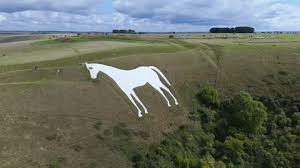Westbury White Horse: Ancient Monument at Centre of Flag Controversy Sparks Heritage Debate

Recent Incident Draws Attention to Historic Landmark
The historic Westbury White Horse in Wiltshire has become the focus of public attention after red fabric was pinned across it to form a St George’s Cross. The controversial addition has since been removed from the ancient landmark.
English Heritage, the site’s custodian, has announced they are now assessing whether any damage has been caused to the beloved monument, particularly from the pegs used to attach the fabric.
Historical Significance and Features
The Westbury White Horse, situated on the escarpment of Salisbury Plain about 1.5 miles east of Westbury, holds the distinction of being the oldest of Wiltshire’s eight white horses. It dates back to the late 17th or early 18th century. The impressive figure measures 180 feet in height and 170 feet in width, serving as a prominent symbol for the town of Westbury.
Conservation and Maintenance
The horse’s maintenance history reveals interesting details about its preservation. While it originally required scouring to maintain its white appearance, with the last recorded scouring in 1853, the 1950s saw it covered in white-painted concrete. This was later replaced in 1993. English Heritage has since developed specialized maintenance methods, including a steam cleaning system first implemented in 2006, which creates a clean surface for environmentally friendly white paint application.
Looking Forward
The Westbury White Horse, created in 1778, maintains its status as one of the best-preserved white horses in Wiltshire, largely due to its prominent location on Westbury Hill, Bratton Down. Recent conservation efforts have included cleaning and repainting rounds in 2011, 2016, and 2018, with an extensive clean and repair work conducted in 2023, involving conservation teams abseiling down the horse’s near-vertical face.
